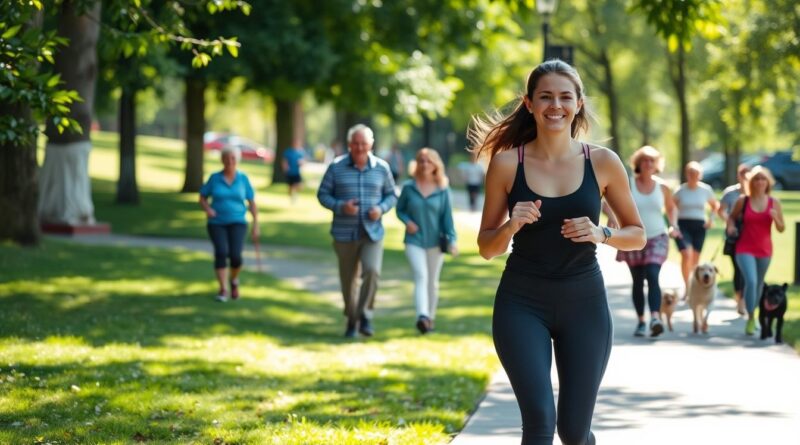How to Lose Weight with Walking Only: A Simple Guide
Want to lose weight? Try walking. It’s easy on your joints and works for everyone. Walking boosts your metabolism and burns calories.

Walking regularly also makes you healthier. It lowers the risk of heart disease and diabetes. As you walk more, you’ll feel better physically and mentally. Walking helps you lose weight and keep it off.
Key Takeaways
- Walking is a simple and effective way to lose weight.
- Regular walking can improve overall health and well-being.
- Incorporating walking into your daily routine can boost metabolism.
- Consistent walking can lead to sustained weight loss.
- Walking is a low-impact exercise suitable for all fitness levels.
The Science Behind How to Lose Weight with Walking Only
To understand how walking can lead to weight loss, we must examine the science behind it. Walking is a form of aerobic exercise. It not only burns calories but also improves overall health.
How Walking Creates a Calorie Deficit to Help You Lose Weight by Walking
Creating a calorie deficit is key to weight loss, and walking helps a lot. When you walk, you burn calories, which helps create the calorie deficit needed for weight loss.
Understanding Your Basal Metabolic Rate to Support How to Lose Weight with Walking Only
Your Basal Metabolic Rate (BMR) is the calories your body needs for basic functions. Walking, along with other activities, increases your daily energy use. This helps create a calorie deficit when added to your BMR.
Calculating Calories Burned While Walking
The calories you burn while walking depend on your weight, pace, and distance. For a 154-pound person, a 30-minute brisk walk can burn 150-200 calories. Online calculators or fitness trackers can give a more accurate estimate based on your specifics.
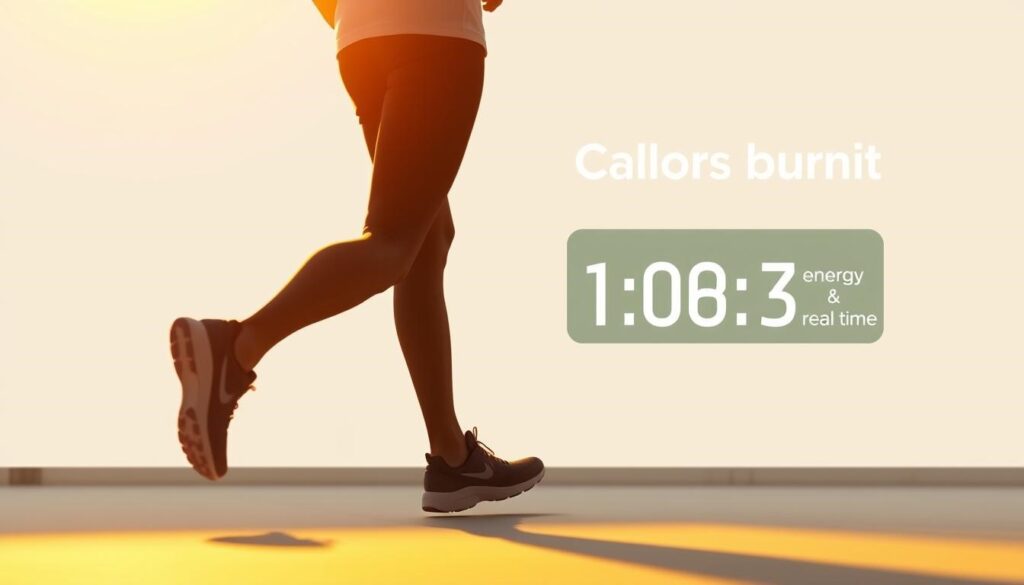
Walking vs. Other Forms of Exercise: Why You Should Walk for Weight Loss
Walking is compared to other exercises like running for fat burning. Walking is low-impact and easier on the joints than running. While running might burn more calories per minute, walking can be done more often and longer, leading to similar or greater calorie burn over time.
Metabolic Benefits of Regular Walking
Regular walking burns calories during the activity and has long-term benefits. It improves insulin sensitivity and fat metabolism and boosts metabolic rate, which contribute to sustained weight loss over time.
Top Benefits of Walking for Weight Loss Beyond Just Burning Calories
Walking is more than just a way to burn calories. It greatly improves health and well-being, making it a great choice for those trying to lose weight.
Improved Cardiovascular Health from Walking: A Key to How to Lose Weight with Walking Only
Walking is good for your heart and blood flow. It can lower blood pressure and increase oxygen in your body, which helps your body burn fat more efficiently.
Reduced Stress and Cortisol Levels
Walking reduces stress by releasing happy hormones. Lower stress means less cortisol, a fat-storing hormone. This helps you lose belly fat.
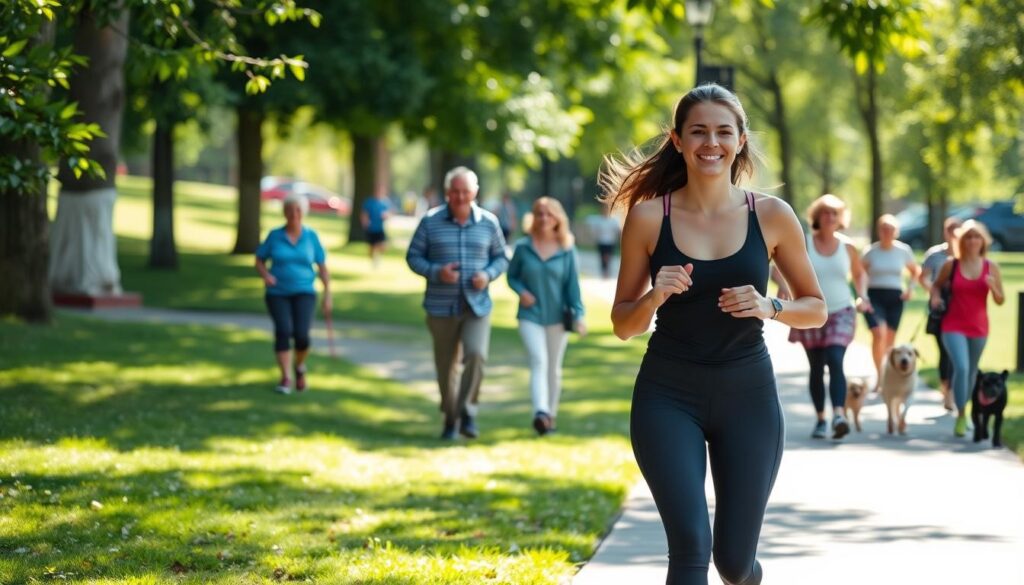
Enhanced Mood and Mental Well-being
Walking boosts your mood with happy hormones. Feeling good helps you stay on track with your weight loss goals.
Joint-Friendly Exercise Option
Walking is easy on your joints. It’s perfect for those with joint problems or chronic pain.
Why Walking Is Ideal for Those with Joint Issues
Walking is gentle on your joints. It’s a low-impact exercise that still works well for weight loss.
Walking vs. High-Impact Exercises
High-impact exercises like running can hurt your joints. Walking is a low-impact option that’s just as effective without the risk of injury.
| Exercise Type | Impact on Joints | Calorie Burn |
| Walking | Low | Moderate |
| Running | High | High |
| Swimming | Low | High |
Getting Started: Your First Walking Plan to Lose Weight by Walking
Starting a walking journey for weight loss is exciting. First, you need to know your current fitness level. This helps you make a walking plan that fits you.
Assessing Your Current Fitness Level
Think about your current activity, health concerns, and walking experience. A simple 1-mile walk test can show your fitness level.
Setting Realistic Weight Loss Goals
It’s important to set weight loss goals you can reach. Break down big goals into smaller, easier ones.
Short-term Milestones
Short goals might include walking several steps daily or walking for 30 minutes without stopping. These goals keep you motivated and track your progress.
Long-term Objectives
Long-term goals could be losing a specific amount of weight or walking a long distance without getting tired in a few months. Clear goals help you stay focused on your journey.
Lose Weight by Walking: Create Your Beginner Walking Schedule
Start with easy walks and gradually make them more prolonged and more frequent. For example, start with 10-minute walks three times a week. Then, increase to 30-minute walks five times a week.
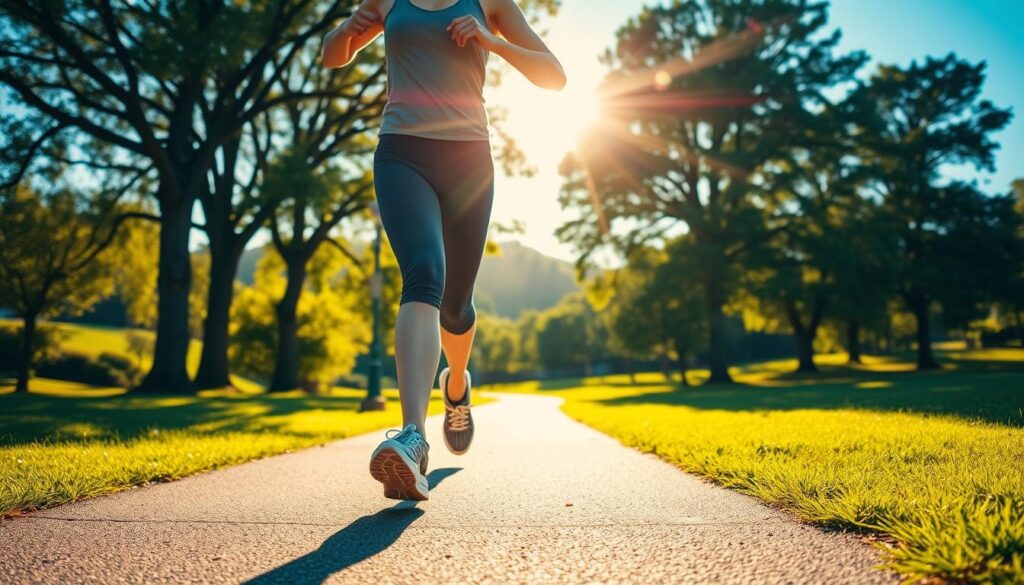
Safety Considerations for New Walkers
Safety is key for a new walker. Wear the right clothes and shoes, stay hydrated, and be aware of your surroundings. It’s best to walk during the day and tell someone where you’re going.
Following these tips can help you create a safe and effective walking plan that will help you reach your weight loss goals.
How to Lose Weight with Walking Only: Effective Strategies to Walk for Weight Loss
Walking for weight loss is more than just walking. It’s about doing it with purpose and strategy. To lose weight effectively, consider several key factors.
Finding Your Optimal Walking Pace
Your walking pace is key to weight loss. A slow pace will not challenge you enough, and a fast pace can be hard to keep up with.
The Talk Test Method
The talk test is a simple way to check your pace. If you can talk easily, you’re not walking fast enough. If you can’t breathe to speak, you’re walking too fast.
Heart Rate Monitoring
Another method is monitoring your heart rate. For moderate walking, aim for 50-70% of your max heart rate. Calculate this by subtracting your age from 220 and multiplying by 0.5 and 0.7.
Duration vs. Intensity: What Matters More
Both duration and intensity matter for weight loss. But for beginners, start with longer walks. This is easier and more sustainable.
As you get more comfortable, increase your intensity. This will help you see better results.
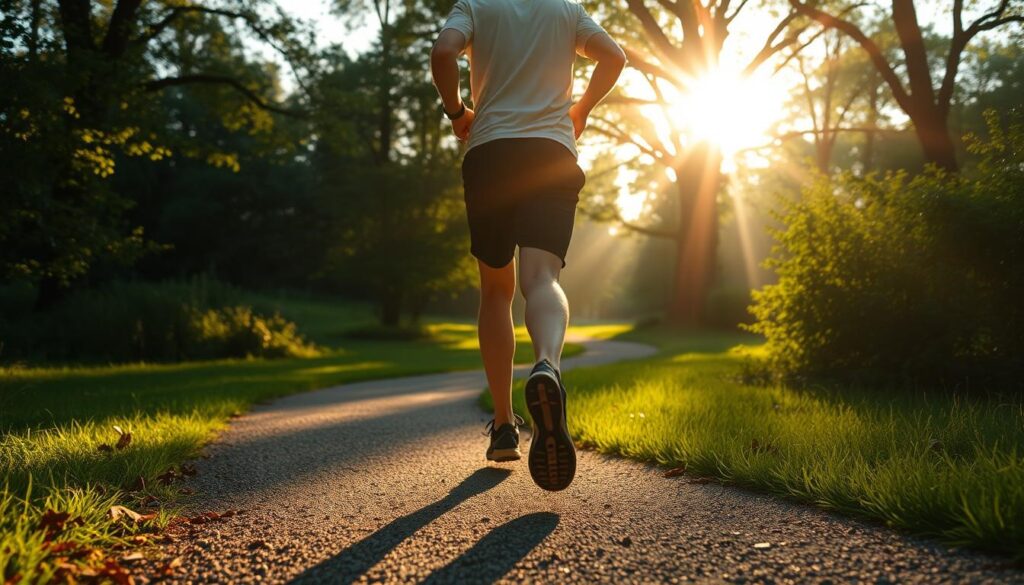
Progressive Overload Principles for Walking
Progressive overload works for walking, too. It means making your walks harder over time. You can add distance, intensity, or inclines.
Consistency: The Key to Results
Consistency is key, no matter your strategy. Walk at the same time every day or every other day. This makes it a habit and helps you see results.
Using these strategies, you can improve your walking for weight loss, which will help you reach your goals more effectively.
Different Walking Techniques to Walk for Weight Loss and Maximize Calorie Burn
To boost your weight loss journey, try different walking techniques. These can help you burn more calories. By changing your walking routine, you challenge your body in new ways, leading to more effective weight loss.
Interval Walking for Fat Loss
Interval walking mixes brisk and slow walks. It boosts your metabolism and calorie burn.
Sample Interval Walking Workouts
Start by walking for 5 minutes briskly, then 3 minutes slowly. Repeat for 30 minutes. This is a great way to burn calories.
Incline Walking Benefits
Walking uphill increases calorie burn. It works your leg muscles harder and raises your heart rate.
Natural Inclines vs. Treadmill Settings
You can walk uphill outdoors or on a treadmill. Both are effective. Outdoor walking adds the benefit of changing scenery.
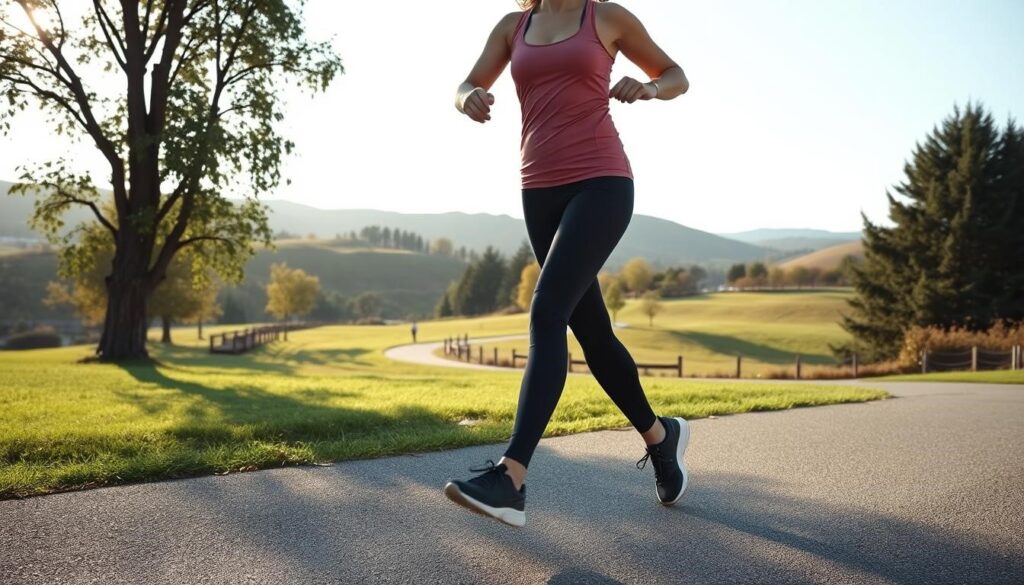
Power Walking Technique
Power walking is fast-paced, with arms pumping. It burns more calories by working more muscles.
Nordic Walking for Full-Body Engagement
Nordic walking uses poles for upper body work, turning walking into a full-body workout. This can increase calorie burn by up to 20%.
| Walking Technique | Calorie Burn Increase | Primary Benefits |
| Interval Walking | High | Boosts metabolism and improves cardiovascular health |
| Incline Walking | Very High | Engages leg muscles intensely, boosts heart rate |
| Power Walking | High | Engages upper body, increases overall muscle engagement |
| Nordic Walking | Very High | Full-body engagement increases calorie burn by up to 20% |
Essential Equipment You Need to Lose Weight by Walking Effectively
Starting a walking weight loss journey needs more than just wanting to do it. You need the right gear for comfort and success. The right equipment makes walking better and helps you reach your weight loss goals.
Choosing the Right Walking Shoes
Finding the right walking shoes is key to a good walking weight loss plan. Good shoes support your feet and make walking more comfortable, reducing injury risk and improving your walks.
Features to Look For
- Arch Support: Good arch support keeps your feet right and reduces foot strain.
- Cushioning: Cushioning absorbs step impact, making walks more comfortable.
- Breathability: Breathable shoes keep your feet cool and dry.
When to Replace Your Walking Shoes
Replace your walking shoes every 300 to 500 miles or every 3 to 6 months. This depends on how often and how hard you walk.
Comfortable Clothing for Different Weather Conditions
Wearing the right clothes for walks is essential for comfort and safety. Choose clothes that breathe, wick moisture, and fit the weather.
Useful Accessories: Pedometers, Fitness Trackers, and Apps
Tools like pedometers, fitness trackers, and walking apps can help your walking weight loss journey. These tools track your progress, help set goals, and motivate you.
| Accessory | Function | Benefits |
| Pedometers | Track steps and distance | Monitor daily activity, set step goals |
| Fitness Trackers | Monitor heart rate, calories burned, and more | Comprehensive tracking, detailed insights into your progress |
| Walking Apps | Guide walks, track routes, and provide motivation | Variety of walking routes, motivational support, and social sharing |
Optional Equipment to Enhance Your Walks
Add extra gear like trekking poles or wearable tech to improve your walks.
Creating a Progressive Walking Schedule to Walk for Weight Loss Continuously
To keep losing weight by walking, you need a plan that gets harder and keeps you going. A good plan keeps you excited and helps you reach your goals.
Beginner Schedule (Weeks 1-4)
Start with walks you can handle and then make them longer and harder. Here’s a simple plan to begin:
Daily Walking Goals
Walk for at least 30 minutes every day, five days a week. Start with short walks and increase in length as you improve.
Weekly Progression Plan
- Week 1: Walk for 30 minutes, 5 days a week at a moderate pace.
- Week 2: Increase the duration to 35 minutes, maintaining the same frequency and pace.
- Week 3: Introduce interval training by incorporating 2 minutes of brisk walking and 3 minutes of regular pace.
- Week 4: Continue interval training and increase the duration to 40 minutes.
| Week | Duration (minutes) | Frequency (days/week) | Pace |
| 1 | 30 | 5 | Moderate |
| 2 | 35 | 5 | Moderate |
| 3 | 35 | 5 | Interval |
| 4 | 40 | 5 | Interval |
Intermediate Schedule (Weeks 5-8)
If you’re already walking regularly, it’s time to make it harder. Walk for 45 minutes and try more intense intervals.
Advanced Schedule (Weeks 9-12)
Now, walk for at least 60 minutes, with significant changes in intensity. Try walking uphill or power walking to burn more calories.
Overcoming Plateaus in Your Walking Routine
If you’re not losing weight anymore, it’s time for a change. Try new routes, add strength training, or try Nordic walking.
By sticking to a progressive walking plan, you can keep losing weight and get healthier.
Tracking Your Progress and Staying Motivated to Lose Weight by Walking
Starting your walking journey to lose weight is exciting. It’s key to track your progress and stay motivated. Seeing how far you’ve come helps you know what’s working and what to tweak, keeping you focused on reaching your weight loss goals.
Effective Metrics to Monitor Beyond the Scale
The scale is helpful, but it’s not everything. Tracking other metrics gives a complete picture of your journey.
Body Measurements
Take body measurements regularly. They show changes in your body composition better than weight alone.
Energy Levels and Fitness Improvements
See how your energy and fitness grow with walking. These signs of progress are just as vital as weight loss.
Using Technology to Track Your Walking
Use tech to monitor your walks. Pedometers, fitness trackers, and apps help you track distance, pace, and calories burned.
Building a Support System
Surround yourself with people who support your walking. Join groups or find a walking buddy to boost your motivation.
Celebrating Non-Scale Victories
Recognize and celebrate your wins, like better mood and more energy. These achievements show your progress beyond weight loss.
- Celebrate milestones like completing several walks or reaching a new distance.
- Reward yourself with non-food items, like a new walking accessory or a relaxing bath.
- Share your successes with friends and family to reinforce your motivation.
Tracking your progress and staying motivated help you stick to your walking routine. This will increase your chances of reaching your weight loss goals.
Nutrition Tips That Support How to Lose Weight with Walking Only
Are you starting your walking weight loss journey? It’s key to eat the right foods. A balanced diet boosts walking’s weight loss benefits.
Fueling Your Walks: Before and After
Think about what you eat before and after walking. An hour before walking, eat a light meal or snack with complex carbs and protein. After walking, refuel with protein and carbs to help muscles recover.
Hydration Strategies for Walkers
Staying hydrated is vital for walkers. Drink water before, during, and after walks, especially on long or hard days.
Signs of Dehydration to Watch For
- Dark yellow urine
- Dizziness or lightheadedness
- Fatigue
- Headaches
Electrolyte Balance for Longer Walks
For long walks, use electrolyte-rich drinks or supplements. This is key in hot weather or intense walks.
Simple Dietary Changes to Enhance Weight Loss
Simple diet changes can boost your weight loss. Eat whole foods like veggies, fruits, lean proteins, and grains. Cut down on sugary drinks and fatty foods.
Avoiding Common Nutrition Mistakes
Watch out for common diet mistakes. Don’t skip meals to avoid overeating later. Also, watch portion sizes to stay in a calorie deficit.
Conclusion: Embracing the Habit to Walk for Weight Loss and Keep It Off
Walking is a simple yet effective way to lose weight and improve health. Adding walking to your daily routine can burn calories and boost your metabolism. It also helps your mental health by reducing stress and improving your mood.
To make walking a lifelong habit, create a routine you can keep up with. Find a walking buddy, track your progress, or try new routes. This way, walking becomes a consistent part of your life, bringing benefits for years.
Stay motivated by celebrating your progress and setting new goals. With persistence and dedication, you can reach your weight loss goals. Walking is a powerful tool for maintaining a healthy weight.
FAQ
How many calories can I burn by walking?
Walking burns calories based on your weight, pace, and distance. On average, you can burn 150-200 calories per mile.
Is walking enough to lose weight?
Yes, walking can help you lose weight. It creates a calorie deficit, which is key for weight loss.
What is the best walking routine for weight loss?
For weight loss, walk at a moderate to brisk pace for 30 minutes several times a week. To burn more calories, try interval training and incline walking.
How often should I walk to lose weight?
Walk 3-4 times a week, for at least 30 minutes each time. Consistency is crucial for weight loss.
Can I lose weight by walking on a treadmill?
Yes, treadmill walking is effective for weight loss. You can track your progress by adjusting the incline, pace, and duration.
How does walking compare to running for weight loss?
Walking and running both help with weight loss. Walking is easier on the joints, while running burns more calories per hour. Walking is excellent for beginners because it can be done for longer periods.
What are some tips for staying motivated to walk for weight loss?
Stay motivated by walking with a buddy, tracking your progress, and rewarding yourself. Try new routes or types of walks, like interval training or Nordic walking.
Can I walk off belly fat?
Yes, walking can help reduce belly fat. Regular walking burns visceral fat, which is fat around the abdominal organs.
How long does it take to see weight loss results from walking?
Weight loss from walking varies based on your starting weight, diet, and routine. Regular walking can produce results in 6-8 weeks.
Read More

